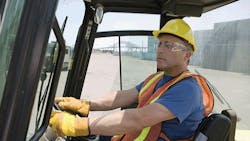Improve Safety for Forklift Operators by Maximizing Peripheral Vision
Safety is a primary concern for anyone who works in construction and manufacturing performing any activity that requires eye protection. The proper eye protection especially is important for those who operate forklifts and other types of mobile equipment.
Simply putting on the latest fashionable safety glasses is not enough in the case of forklift operators. Frames that impair the ability of mobile equipment operators to see people and objects with minimal head turning or moving their eyes can contribute to unsafe situations. In the case of forklift operators, peripheral vision is important.
Maintaining peripheral vision is essential to detecting motion and a key element to safety. Yet many forklift drivers wear newer fashion or wrap-style safety glasses that greatly reduce the field of vision and thereby increase the chances for a serious accident.
Forklift Safety Stats
Forklift accidents certainly are not uncommon. According to the 2014 edition of Injury Facts from the National Safety Council, 66 workers died as a result of operating or working near a forklift. A forklift was a secondary source of fatal injuries for an additional 24 workers. Those numbers are up from 2010. Estimates place the cost to U.S. employers of forklift accidents at over $135 million per year.
Many of these costs involve workers' compensation payments, but also include hidden costs such as workers' lost time and training costs for replacement workers. Greater costs occur from major lawsuit awards from forklift accidents. All of these costs can add up and negatively impact a corporation. These injuries often occur to workers who are walking or working near forklifts, and who are not seen by the trained forklift operator.
Impact of Safety Eyewear
One company, Industrial Vision Corp., was curious about the number of forklift incidents that could be attributed to vision issues related to safety eyewear. The company created its own study utilizing professional opticians. Though non-scientific, the firm analyzed several prescription frames – including several wrap-style safety glasses – to determine how they affected sight lines.
The opticians first defined the field of vision as measured in terms of degrees from the center. The established baseline for a person with a healthy and normal eye should be to see approximately 95 degrees toward their ear and approximately 60 towards their nose. This means that each eye provides a horizontal field range of 155 degrees.
Then, field of vision was measured for each of the test safety glasses. Full field of vision was found to decline from approximately 85 degrees to approximately 77.5 degrees – a loss of 10 degrees and 17.5 degrees, respectively, in the to-the-ear measurement. In the worst-case scenario, one of the frames reduced peripheral vision by 68 percent. Not only was normal vision less acute, but the eyewear created blind spots that only could be seen by a full head turn.
This is not an indictment for wrap-style safety eyewear for many occupations. They can be most appropriate for on-the-job use when side-to-side vision is not key to workplace safety. Studies have even shown that workers are inclined to become more compliant with corporate safety standards when given the opportunity to wear more fashionable approved eyewear. Therefore, fashion frames certainly encourage better participation.
However, safety directors should consider the importance of unobstructed peripheral vision for industrial truck operators. Even though they may be marked compliant with ANSI Z87.1, many still lack the depth of vision necessary to operate mobile equipment.
Eyewear that provides clear peripheral vision, even with clear and transparent side shields, will provide a better field of vision than any that impair the ability to see side-to-side images.
While most of us are unable to determine exact detail of what is seen though our peripheral vision, even seeing "something" can be a critical factor while driving mobile equipment and forklifts. The ability to visualize a person or object could mean the millisecond of a difference between being safe, or becoming another workplace statistic.
John Stewart is president of Industrial Vision Corp. The firm specializes in bringing professional eye protection services to clients' facilities. Stewart can be contacted at [email protected] or at 800-264-1941.

